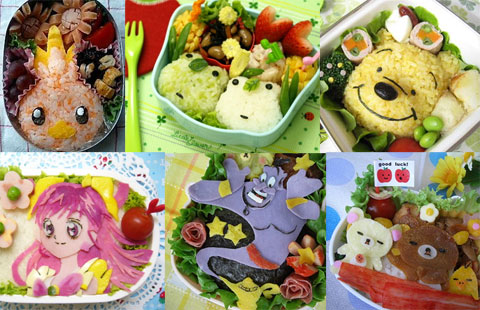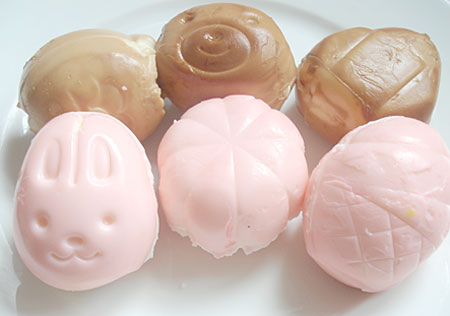Natural ways to make your bento colorful

If you love character bentos (kyaraben), you may wonder how the creators manage to color some of the elements. Do they use food dyes? Not necessarily. Bentobako.net, called Ranchi-ryuu Obentoubako Community (Lunch-style Bento Community) is an attractive and very useful bento resource site in Japanese. One of the most interesting sections that they have recently set up is the Bento Coloring Dictionary, a reader-contributed section with lots of ideas for making various bento elements colorful without resorting solely to food dyes. Here are some of the ideas listed there, arranged by color, with my notes in parentheses.
I've added the formulas for deriving 3 (or 4) different colors from one ingredient - red cabbage juice!
Orange
- Orange colored rice: Mix in some salmon flakes to make the rice a light orange. (how to make your own salmon flakes. I think you would need to start with quite deeply red/orange wild salmon for optimum coloring.)
- Orange colored rice 2: Grate some carrot, mix with a little salt, and microwave for a couple of minutes. Mix into cooked rice. (This is the method used for the orange chick in the left top photo.)
- Orange colored rice 3: Mix grated carrot, a little soy sauce and butter, nuke and mix into cooked rice. (Makes a deeper orange colored rice.)
- Light orange colored egg: Make _usuyaki tamago_ (thin omelettes) with egg whites only, and mix in some paprika. (Use sweet paprika if you don't want it to be hot-spicy.)
- __Deeper orange colored egg: Make _usuyaki tamago_ (thin omelettes) with whole egg plus a little ketchup.
Pink or peach
- Deep pink ham: Ham is a light pink in color, but to make it a deeper pink (such as for the girl's hair in the left bottom photo above), immerse it for a few minutes in ume vinegar. (If you can't get a hold of ume vinegar I think raspberry vinegar may work. May make the ham rather sour though!)
- Light pink/flesh colored rice: Grind up some sakuraebi (small dried shrimp), and mix into rice. Good for making faces with rice.
- Pink eggs: Red cabbage liquid plus a few drops of lemon juice. Use the liquid to dye boiled eggs. (This is not mentioned on the site yet, but I've used it for making these pink eggs for my Fun With Japanese Egg Molds article. You need to completely immerse the eggs in the liquid and leave it overnight. See more about red cabbage liquid below. The brown eggs, incidentally, are colored with soy sauce.)

- Bright pink sushi rice: You can buy something called denbu or sakura denbu at Japanese grocery stores. This is dried flaked cod that has been colored with food coloring. This can be mixed into rice (sushi rice is best) to make bright pink rice. Not totally natural, but colored denbu is used in sushi rolls....
Purple
- Purple ham: Marinate pink ham in red cabbage liquid (see pink eggs above, but don't add lemon juice) to make blue-purple ham! (Method used for the Genie in the photo at top.) You can also use red cabbage liquid to color kamaboko, sausage, and so on.
- Using purple potato powder: Purple potato powder is mentioned several times - for making bread, melting with cheese, mixing into crepe batter, and so on. (I don't know if you can get a hold of purple potato powder, but maybe you could do something with those purple potatoes...)
Blue
- Red cabbage juice again: Mix in a little bit of baking soda to red cabbage juice and it turns blue. Use this to color ham, sausage, kamaboko.... (I used this formula for making the 'blue' eggs in the Egg Mold article, though I decided that blue eggs just look supremely inedible!)
- Purple potato powder again: It seems purple potato powder can turn things blue or purple, or perhaps something in between.
- Pickled eggplant liquid: Eggplant (aubergine) emits a blue-purple colored liquid. Use that liquid to dye ham, etc. (Shibazuke is a mostly eggplant pickle that is easily available at Japanese grocery stores.)
Yellow
- Bright orange-yellow rice: Mix in some mashed kabocha squash - using frozen kabocha is the most convenient.
- Yellow rice with curry flavor: Mix a little curry powder with hot water and soup stock powder, and mix with rice. (Method used for the Pooh face in the top photo.)
- Light yellow rice: Take out the yellow bits (dried egg) only of noritama furikake, and mix in with rice. (I would think you could use mashed up cooked egg yolk just as well)
- Yellow steamed buns: Make steamed buns, but add a little curry powder to the dough. (You could add turmeric instead of curry powder, but remember that curry is a very common ingredient in Japan.)
Green
- Green rice with edamame: Grind/mash up some edamame, and mix into cooked rice, for a light green color. (Used for the frog in the top photo. This one sounds really good to me - I'll have to try it out! Mashed green peas should work too.)
- Green rice with broccoli: Chop up some broccoli stalks finely, stir around in a dry frying pan to take out excess moisture, flavor with salt and pepper or even with mayonnaise (!), and mix into rice.
- Green eggs, no ham: Finely grind up some blanched spinach leaves and make _usuyaki tamago_ (thin omelettes). (I think the microwave usuyaki tamago method described by Biggie may be rather suited to this.)
Brown
- Use inarizushi skins - right site out and inside-out: Use storebought inarizushi skins as-is for dark brown, and flip them inside out for light brown.
- Dark brown egg yolk omelettes: Use the yolks only, plus dark soy sauce (tamari would do) for making smoothly dark brown _usuyaki tamago_ (thin omelettes), but mix in a little flour to stablize the batter. (Method used for the dark brown Rirakkuma in top photo. Mixing soy sauce into the whole egg results in a medium-brown omelette.)
- Meaty brown rice: Mix meat soboro with rice.
- Saucy brown rice: Mix soy sauce with butter, just soy sauce, or tonkatsu sauce (or Worcestershire sauce) into rice to turn it a light to medium brown.
Black/grey
- The best black is nori seaweed!
- Grind up some shirasuboshi (tiny little semi-dried fish) and mix into rice for a grey rice, suitable for making Totoro for instance.
The magic of red cabbage juice
The first time I saw red cabbage juice being used as a magical natural food coloring was on the popular Japanese TV show called _Ito-ke no shokutaku_ (The Ito Family's Dinner Table - no relation!). They used it to produce pink and blue takoyaki! Red cabbage juice popped up a few times in the coloring methods, so here are the formulas for producing various colors.
- First start with raw red cabbage leaves. Chop them up any way you like - roughly if you just intend to discard them later, or sliced thinly if you want to use them. (You could use them to make coleslaw, for instance.)
- Add to already boiling water. Allow for about 2 cups of cabbage to 4 cups of water. Boil for just a minute or two. This extracts the color from the leaves, but not the cabbage-y flavor.
- For purple, use the liquid straight.
- For red (which is actually more like a bright pink), add a few drops of lemon juice or another acid like vinegar. You'll see it magically turn red before your eyes!
- For blue, add a little baking soda. It's best to make a baking soda slurry of sorts and add that liquified form to the water bit by bit. Beware though - if you add too much baking soda the liquid, and whatever you marinate in it, will taste like baking soda, which is not very pleasant.
- For brown (though I don't know why you'd need this since so many other things are naturally brown), add egg yolk.
I'm fairly sure you could use beets in a similar way, but have yet to try them out (and beets are not a very common vegetable in Japan, so I don't see them used at all in bentos there.)
Be sure to visit the original Bento Coloring Dictionary for photos representing the coloring methods - clicking the colored tabs at top lead you to each color section.
I hope these coloring methods have given you some ideas and gotten your creative juices (no pun intended) flowing. If you have other ways of naturally coloring your food for fun, please let us know in the comments!
If you enjoyed this article, please consider supporting this site by becoming my patron via Patreon.
